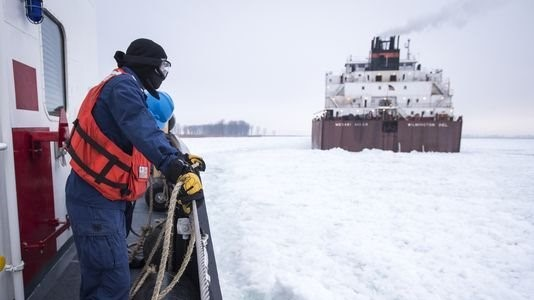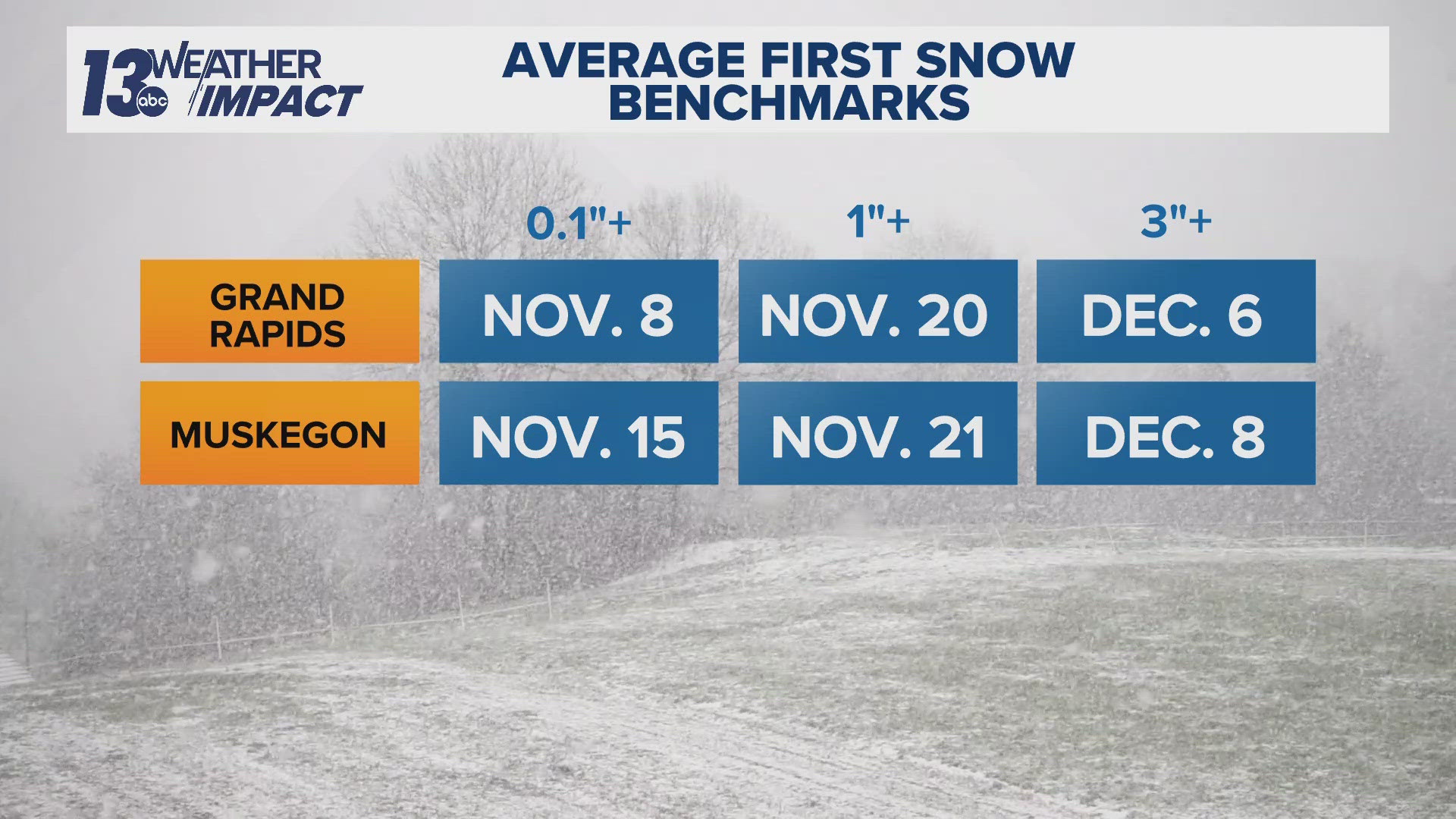The Mesabi Miner got stuck in the ice. The 1,004-foot bulk carrier had sailed south down the St. Clair River and toward Lake St. Clair on Jan. 10, navigating through the river's southern channel south of of Harsens Island.
This shipping lane is the most difficult to navigate in the great lakes, according to Lt. Andy Perodeau, captain of the U.S. Coast Guard icebreaker Neah Bay.
It's the Neah Bay's job to get ships like the Mesabi Miner loose. Inward pressure from the ice makes it difficult to maneuver the larger ship through the channel's turn, Perodeau said. The Mesabi Miner's movement is further restricted by the depth of the channel — if it turns too hard it could run aground.
The bigger the ship and the colder the water, the more difficult it is to move through the ice. But as long as there's thick ice on the surface, and shipping must get through, the United States and Canadian coast guards run icebreakers to keeping things humming along.
The sun rises behind the USCGC Neah Bay before launching from Algonac Jan. 10. The U.S. Coast Guard uses the cutter to help clear shipping channels of ice so cargo ships can pass through. (Photo: Brian M. Wells/Times Herald)
Earlier that day...
Right around sunrise, the Neah Bay set off. Its prow chopped through the icy surface of the St. Clair River.
The vessel and its 19 crew members pulled away from their mooring near the Algonac Clay Historical Museum in Algonac. They headed downriver to begin the day's ice breaking operations.
At the top of the morning, the ship does a pass to bust up the ice before the larger ships arrive. A little bit of preventative effort can go a long way.
"Once a vessel gets stuck, it's very difficult to move them," Perodeau said.
Seaman Najee Williams, 19, from Savannah, Ga., pilots the USCGC Neah Bay down the frozen St. Clair River Jan. 10. Williams has spent two months of his year with the Coast Guard on the Neah Bay. "I really did want to drive ships," says Williams," I love being on the ice breaker. You get to do stuff (other ships) don't usually do." (Photo: Brian M. Wells/Times Herald)
Seaman Najee Williams, 19, took a turn on the wheel that morning. Originally from Savannah, Georgia, Williams said he wanted joined the Coast Guard because he likes to do adventurous stuff. He'd been in the Coast Guard for about a year, and on the Neah Bay for the past two months.
"I really did want to drive ships," Williams said. "I love being on the icebreaker. You get to do stuff (other ships) don't usually do."
The icebreaker’s prow does much of the work, but the ship’s wake also helps. The rolling action of the wake tosses about the smaller chunks of ice, called brash. The ship has a bubbler, which pumps air into the water to further toss the brash and push it away from the ship's hull.
As part of the USCGC Neah Bay’s pre-departure checklist, the crew checks the ship’s bubbler system. The system pushes ice chunks known as brash away from the ship to help prevent it from becoming stuck. (Photo: Brian M. Wells/Times Herald)
Brash gradually layers up as larger sheets of ice break up. In the past few days, the brash had been about 45 inches deep in some places, Perodeau said.
The lapping of the water wets the brash, which decreases friction and helps ships move through. This makes it into more of a thick slush than a hard block of ice, thus making it easier to move through. The icebreakers create visible routes through the ice for ships to follow through.
The Neah Bay has a maximum speed of 15 knots, about 20 miles per hour. It doesn’t move too quickly, but is built for torque. The ship’s shorter length of 140 feet makes it more maneuverable in waterways clogged with ice.
Meanwhile below deck
In the ship's galley, commissaryman petty officer second class Billy Shuck worked on lunch. On the menu — BBQ chicken with tater tots and brownies.
While the rest of the crew works in different areas of the USCGC Neah Bay, CS2 Billy Shuck, from Lorrain, Ohio, cooks tater tots and barbecue chicken sandwiches in the ship's galley for the Jan. 10 noon meal. When the other branches of the military, Shuck brought his extensive culinary history to the Coast Guard seven years ago. (Photo: Brian M. Wells/Times Herald)
"I've always worked in and out of restaurants," Shuck said. "I love cooking food and I love my country."
His day usually starts at 6 a.m. when he wakes up and starts working on breakfast. After that he helps launch the ship each morning. After he's finished cleaning up from breakfast, it's about time to start on lunch.
After lunch he does some prep work for the next day before starting on dinner. Once that's finished, it's time to help bring the boat in, usually around 8 p.m.
Chief BMC Andrew Thompson, left, BM3 Ricky Reese, center, and E3 Fireman Joseph Kraus watch "The Price Is Right" while eating their noon meal in the galley of the USCGC Neah Bay Jan. 10. Spotty satellite TV service provides the crew with entertainment during their limited downtime. (Photo: Brian M. Wells/Times Herald)
The ship's galley is the main common area for the crew. Their two TVs keep a pretty steady picture, but occasionally cut out when the signal has problems. A small refrigerator of drinks sat across from a table in the middle of the room. A bench lined the wall across from the kitchen and a restaurant-style booth sat tucked in the corner.
Shuck makes a variety of food for the crew, including Mexican, Italian and traditional American fare. But one things stands out to him as the crew's favorite.
"Anything with bacon in it is good," Shuck said.
Getting cargo through
After finishing up its initial clearing run, the Neah Bay doubles back to meet with vessels seeking to pass through the channel. The Coast Guard escorts each ship through the difficult stretch of the channel.
While at first it was smooth sailing, this is when the Mesabi Miner got stuck. When this happens, icebreakers have a couple oftechniques they can use to free the ship.
The main thing is relieving the inward pressure from the ice pushing against the ship. Icebreakers can do this by sailing close by the other ship's hull to break up the ice. An icebreaker might sail in circles around the ship to break up the ice on all sides.
The Neah Bay normally breaks through the ice by simply moving straight forward. One method to break through is the “back and ram,” which is what it sounds like. The ship kicks into reverse, then speeds up to strike the ice as hard as possible.
“If we’re getting stuck, a regular ship has got no shot,” Perodeau said.
The ship can also weave back and forth to further break up ice, a maneuver called “sallying the rudder.”
Crewmembers aboard the USCGC Neah Bay hold rubber fenders over the side of the ship as it gets close to the stuck Mesabi Miner Jan. 10. Fenders are large rubber bumpers that are designed to prevent the ships from colliding if the ice cutter gets too close. (Photo: Brian M. Wells/Times Herald)
Sometimes, the ships get so close that the crew can touch the other ship's hull. This is what happened for the Mesabi Miner. But this wasn't enough. So after a few passes over a couple hours, the Canadian Coast Guard cutter Samuel Risley arrived to help.
For a while, the Neah Bay sat back and gave the Samule Risely space as it did its passes alongside the Mesabi Miner. But that too wasn't enough. Eventually, the Neah Bay joined the Samuel Risley in its passes. Between the efforts of both ships, the Mesabi Miner slipped free and continued it's journey.
Free at last
It took five hours to move the giant freighter about half a mile. Around 3:45 p.m., word came in that the icebreakers would assist one last ship through the channel before calling it a day. The delays were too long for it to make sense to continue with darkness approaching. Usually the Neah Bay finishes its day around 8 p.m., but sometimes must go later.
After the channel was closed early due to ice, two members of the USCGC wait at the bow of the ship as it approaches the public dock in Algonac Jan. 10, where the ship and it's crew will spend the night. (Photo: Brian M. Wells/Times Herald)
While the cargo ships anchor and settle in for the night, the Neah Bay returns to Algonac. After the ship positioned itself next to land, Seaman Williams jumped from the deck and tied down the vessel.
The crew of the Neah Bay doesn't have a ton of free time. For example, Shuck must use his evenings off the ship to purchase groceries. There's also all sorts of cleaning and maintenance that needs doing.
"The Coast Guard keeps us busy, even when we're in port," Executive Officer Dylan Wright said.
Otherwise, the crew has been hanging out in Algonac's nearby CVS store, the local VFW hall and a couple bars close by.
Not every Coast Guard icebreaker has the opportunity to go ashore for the night. When plowing up ice in the great lakes, the ships are sometimes too far away from land to conveniently park. So instead they stick themselves in a chunk of ice and settle in for the night.
“No one else gets paid to get stuck,” Perodeau said.
►Make it easy to keep up to date with more stories like this. Download the WZZM 13 app now.
Have a news tip? Email news@wzzm13.com, visit our Facebook page or Twitter.


